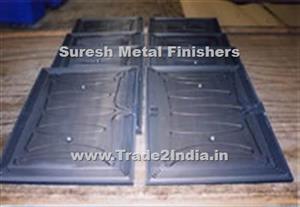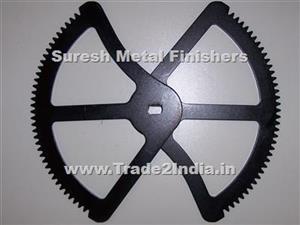
Rhodium Plating
For your Rhodium (Rodium) plating requirements, Suresh Metal Finishers. has facilities for plating both small and large parts in various sized barrels, racks and wiring.
For your Rhodium (Rodium) plating requirements, Suresh Metal Finishers. has facilities for plating both small and large parts in various sized barrels, racks and wiring.
Rhodium is white in color and is a precious metal, meaning non-oxidizing. Rhodium is a member of the Platinum Group of Metals. The Platinum Group of Metals is a group of six metals which include platinum, rhodium, palladium ruthenium, osmium, and iridium. These six metals all share some common physical properties. They have high melting points, are very dense, are very hard, and are very resistant to corrosion.
Rhodium is the hardest of the PGM’s. Its’ hardness is about 800. Compare that to cobalt hardened gold at 200 knoop,14k ElectricGold at 400 knoop and at 400 knoop. Rhodium is the hardest, most wear resistant metal that we plate at Professional Plating. In addition to its’ hardness, rhodium is extremely resistant to corrosion. Rhodium is an excellent choice where contact with corrosive gases or other high corrosion environments will be encountered. Remember also that as the operating environment temperature increases, the corrosion rate will also increase. So in high temperature applications, rhodium will provide a longer life cycle, than, for example, gold will. Rhodium will reliably operate beyond 1000F.
Rhodium is an extremely bright white metal. It is much whiter than palladium and platinum. For this reason and because of its’ extreme hardness, rhodium is very commonly used as an electroplated surface for fine jewelry.
Rhodium plated product is well suited for such applications as sliding electrical contacts that require protection from sliding contact wear or galling. Also, because of its’ high temperature tolerance to oxidation, rhodium is an extremely good choice for high voltage/high amperage electrical contacts where contact arcing would otherwise cause the formation of highly electrically resistive oxide formations on the contact surface.
Rhodium plating specification :
Rhodium Plating The relevant specifications for calling out rhodium plating are =MIL-R-46085 Rhodium Plating, Electrodeposited, and ASTM B 634 – 88 (Reapproved 1999) Standard Specification for Electrodespoitied Coatings of Rhodium for Engineering Use
We have two suggestions for specifying the plating of rhodium:
1. Thickeness of the deposit should be minimized. Electroplated rhodium deposits tend to develop a highly fractured, very dense crystal structure. This high fracture crystal structure contributes directly to the wear hardness and durability of the rhodium surface. However, as the thickness of the deposit increases the possibility of the electrodeposit fracturing and delaminating from the substrate increases. Standard good manufacturing practice for rhodium plating requires that the rhodium bath be kept absolutely free of impurities and continuously monitored for the correct amount of organic stress reduction compounds. When properly maintained, a rhodium electrodeposit of up to 100 micro inches (2.5 micros, 0.000100 inches) is regularly attained.
A typical rhodium thickness would be 20 -30 micro inches. Please call us regarding your specific requirement.
2. It is our standard practice to undercoat all rhodium plating with a thin layer of gold. We strongly suggest that a thin gold upder-layer be included in the plating specification. Typically, plating specifications require only a nickel underplate for performance. However, the gold under-layer, in conjunction with proper bath maintenance will provide the most stress free, dependable electrodeposit.
For your Rhodium (Rodium) plating requirements, Suresh Metal Finishers. has facilities for plating both small and large parts in various sized barrels, racks and wiring.
Rhodium is white in color and is a precious metal, meaning non-oxidizing. Rhodium is a member of the Platinum Group of Metals. The Platinum Group of Metals is a group of six metals which include platinum, rhodium, palladium ruthenium, osmium, and iridium. These six metals all share some common physical properties. They have high melting points, are very dense, are very hard, and are very resistant to corrosion.
Rhodium is the hardest of the PGM’s. Its’ hardness is about 800. Compare that to cobalt hardened gold at 200 knoop,14k ElectricGold at 400 knoop and at 400 knoop. Rhodium is the hardest, most wear resistant metal that we plate at Professional Plating. In addition to its’ hardness, rhodium is extremely resistant to corrosion. Rhodium is an excellent choice where contact with corrosive gases or other high corrosion environments will be encountered. Remember also that as the operating environment temperature increases, the corrosion rate will also increase. So in high temperature applications, rhodium will provide a longer life cycle, than, for example, gold will. Rhodium will reliably operate beyond 1000F.
Rhodium is an extremely bright white metal. It is much whiter than palladium and platinum. For this reason and because of its’ extreme hardness, rhodium is very commonly used as an electroplated surface for fine jewelry.
Rhodium plated product is well suited for such applications as sliding electrical contacts that require protection from sliding contact wear or galling. Also, because of its’ high temperature tolerance to oxidation, rhodium is an extremely good choice for high voltage/high amperage electrical contacts where contact arcing would otherwise cause the formation of highly electrically resistive oxide formations on the contact surface.
Rhodium plating specification :
Rhodium Plating The relevant specifications for calling out rhodium plating are =MIL-R-46085 Rhodium Plating, Electrodeposited, and ASTM B 634 – 88 (Reapproved 1999) Standard Specification for Electrodespoitied Coatings of Rhodium for Engineering Use
We have two suggestions for specifying the plating of rhodium:
1. Thickeness of the deposit should be minimized. Electroplated rhodium deposits tend to develop a highly fractured, very dense crystal structure. This high fracture crystal structure contributes directly to the wear hardness and durability of the rhodium surface. However, as the thickness of the deposit increases the possibility of the electrodeposit fracturing and delaminating from the substrate increases. Standard good manufacturing practice for rhodium plating requires that the rhodium bath be kept absolutely free of impurities and continuously monitored for the correct amount of organic stress reduction compounds. When properly maintained, a rhodium electrodeposit of up to 100 micro inches (2.5 micros, 0.000100 inches) is regularly attained.
A typical rhodium thickness would be 20 -30 micro inches. Please call us regarding your specific requirement.
2. It is our standard practice to undercoat all rhodium plating with a thin layer of gold. We strongly suggest that a thin gold upder-layer be included in the plating specification. Typically, plating specifications require only a nickel underplate for performance. However, the gold under-layer, in conjunction with proper bath maintenance will provide the most stress free, dependable electrodeposit.
















